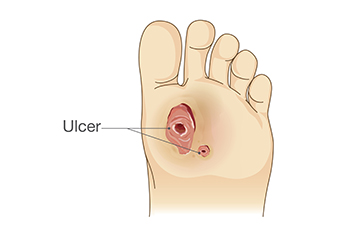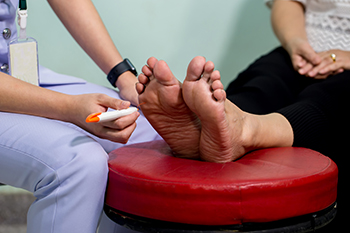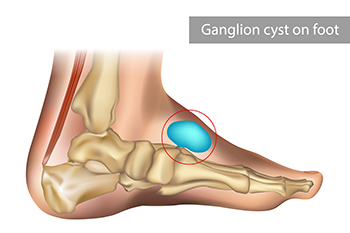
A foot ulcer is a serious wound. It is said to look like a crater in the skin and is generally found on the bottom of the foot or tip of a toe. Thick skin can gradually surround it and may act like a border. A foot ulcer can be common among diabetic patients, and immediate wound care is often sought for treatment and relief. A foot ulcer can range between being a surface wound to a deep wound, and both types can become infected if not treated. Diabetic patients can suffer from neuropathy, which is the inability to feel sensations on the feet. This may also be coupled with poor circulation, which may slow down the healing process. A foot ulcer that develops in people who have good circulation may heal in approximately six weeks, but it may take considerably longer in patients who have poor circulation. Treatment can begin with a podiatrist performing a debridement, which is trimming away diseased tissue. This can be followed by applying an appropriate dressing and recommending specialized footwear. If you have a foot ulcer, it is strongly suggested that you are under the care of a podiatrist who can successfully treat this foot condition.
Wound care is an important part in dealing with diabetes. If you have diabetes and a foot wound or would like more information about wound care for diabetics, consult with Dr. Richard DiMario from Maine. Our doctor will assess your condition and provide you with quality foot and ankle treatment.
What Is Wound Care?
Wound care is the practice of taking proper care of a wound. This can range from the smallest to the largest of wounds. While everyone can benefit from proper wound care, it is much more important for diabetics. Diabetics often suffer from poor blood circulation which causes wounds to heal much slower than they would in a non-diabetic.
What Is the Importance of Wound Care?
While it may not seem apparent with small ulcers on the foot, for diabetics, any size ulcer can become infected. Diabetics often also suffer from neuropathy, or nerve loss. This means they might not even feel when they have an ulcer on their foot. If the wound becomes severely infected, amputation may be necessary. Therefore, it is of the upmost importance to properly care for any and all foot wounds.
How to Care for Wounds
The best way to care for foot wounds is to prevent them. For diabetics, this means daily inspections of the feet for any signs of abnormalities or ulcers. It is also recommended to see a podiatrist several times a year for a foot inspection. If you do have an ulcer, run the wound under water to clear dirt from the wound; then apply antibiotic ointment to the wound and cover with a bandage. Bandages should be changed daily and keeping pressure off the wound is smart. It is advised to see a podiatrist, who can keep an eye on it.
If you have any questions, please feel free to contact our office located in York, ME . We offer the newest diagnostic and treatment technologies for all your foot care needs.

Wearing the right shoes for work may help to prevent potential injuries. Footwear for work can vary and can depend on the type of job that is being done. Falling, rolling, or crushing hazards can require safety-toe shoes to be worn, and may have to meet specific performance standards. The instep can be protected against injury when metatarsal guards, made from aluminum, steel, or plastic, are strapped to the outside of work shoes. If wet floors or flooding is a concern in the workplace, rubber overshoes can be worn, which may also be helpful while standing on concrete. Outside environments may require the employee to wear overshoes or shoes that have studded treads that can protect against slippery surfaces. There are several types of work shoes that are available, and if you would like additional information about which ones to buy, it is suggested to speak with a podiatrist who can guide you toward making the correct choice.
While working on the feet, it is important to take the proper care of them. For more information about working on your feet, contact Dr. Richard DiMario from Maine. Our doctor will treat your foot and ankle needs.
Working on Your Feet
Standing on your feet for long periods of time can cause stress and pain in your feet. Your whole body may experience change in terms of posture, back pain, bunions, callouses and or plantar warts. There are ways to avoid these conditions with proper foot care, smart choices and correct posture.
Positive Changes
Negative heeled shoe – Choosing this shoe type places the heel slightly lower than the ball of the foot. These are great for overall foot health. Find shoes that fit you correctly.
Go barefoot – Our feet were not designed to be enclosed for all hours of the day. Try to periodically expose your feet to air.
Eliminate Pain
Foot Exercises – Performing simple exercises, incorporating yoga and doing stretches are beneficial. This will allow increased blood flow to the area and muscles of the foot.
Achilles tendon – Stretching the foot out flat on the floor will relax the calf muscles and tendon. These exercises can be performed almost anywhere. Make sure you add these exercises to your daily regimen.
With a little bit of this information and knowing more about foot health, you will notice changes. Foot stretches and proper footwear will help with pain and prevent further issues.
If you have any questions please feel free to contact our office located in York, ME . We offer the newest diagnostic and treatment technologies for all your foot and ankle needs.

Many people with diabetes develop foot pain that directly results from their disease. One such condition is diabetic neuropathy, which is caused by nerves that have been damaged by high levels of blood sugar. The cause of severe foot pain is known as focal neuropathy, which affects one nerve at a time. On the other hand, peripheral neuropathy affects all the nerves from the spine to the feet. Factors that make diabetic foot pain more likely to occur include uncontrolled blood sugar levels, poor blood flow to the feet, plaque buildup in the arteries and veins, and genetics. In addition, the risk of diabetic foot pain increases with alcohol abuse and smoking. Having diabetic neuropathy can lead to difficulty walking, foot ulcers, and frequent foot infections. A regular foot hygiene routine is the best way to prevent these conditions from forming or worsening. For more information about foot pain related to diabetes, it is suggested that you make an appointment with a podiatrist.
Diabetic foot care is important in preventing foot ailments such as ulcers. If you are suffering from diabetes or have any other concerns about your feet, contact Dr. Richard DiMario from Maine. Our doctor can provide the care you need to keep you pain-free and on your feet.
Diabetic Foot Care
Diabetes affects millions of people every year. The condition can damage blood vessels in many parts of the body, especially the feet. Because of this, taking care of your feet is essential if you have diabetes, and having a podiatrist help monitor your foot health is highly recommended.
The Importance of Caring for Your Feet
Patients with diabetes should have their doctor monitor their blood levels, as blood sugar levels play such a huge role in diabetic care. Monitoring these levels on a regular basis is highly advised.
It is always best to inform your healthcare professional of any concerns you may have regarding your feet, especially for diabetic patients. Early treatment and routine foot examinations are keys to maintaining proper health, especially because severe complications can arise if proper treatment is not applied.
If you have any questions please feel free to contact our office located in York, ME . We offer the newest diagnostic and treatment technologies for all your foot and ankle needs.

A ganglion cyst on the foot develops near joints or tendons, of which there are many in the foot. It is like a soft pebble filled with a gel-like fluid and is noncancerous. In many cases, a ganglion cyst will disappear or gradually diminish in size, despite the fact it can be quite painful and tender to the touch. Symptoms of a ganglion cyst are a noticeable lump, a tingling or burning pain if it touches a nerve, and irritation that can happen while wearing shoes. A ganglion cyst forms when synovial fluid leaks from a joint or tendon and collects in a sac under the skin. If it is particularly painful and interferes with the completion of your daily activities, a podiatrist can drain the cyst of its fluid and inject it with medication. It is very dangerous to try to pop a ganglion cyst yourself, as this may cause further damage and increase the risk of infection. In severe cases, surgery can be an option. For help with a ganglion cyst on the foot, it is suggested that you make an appointment with a podiatrist who can determine the best options to treat a ganglion cyst.
Foot Pain
Foot pain can be extremely painful and debilitating. If you have a foot pain, consult with Dr. Richard DiMario from Maine. Our doctor will assess your condition and provide you with quality foot and ankle treatment.
Causes
Foot pain is a very broad condition that could be caused by one or more ailments. The most common include:
Diagnosis
To figure out the cause of foot pain, podiatrists utilize several different methods. This can range from simple visual inspections and sensation tests to X-rays and MRI scans. Prior medical history, family medical history, and any recent physical traumatic events will all be taken into consideration for a proper diagnosis.
Treatment
Treatment depends upon the cause of the foot pain. Whether it is resting, staying off the foot, or having surgery; podiatrists have a number of treatment options available for foot pain.
If you have any questions, please feel free to contact our office located in York, ME . We offer the newest diagnostic and treatment technologies for all your foot care needs.